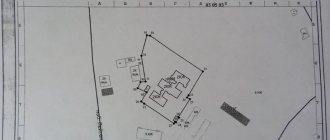The status of a land plot determines its legal status, that is, the opportunities that are available to its owner. Most often, the Rosreestr database contains complete information about the land allotment necessary for its identification. The temporary status of the land plot means that there is not enough information to enter accurate information into the register. Most often, the “temporary” status indicates that the site is simply not registered with the cadastral register.
The cadastral extract contains a line such as “status of the land plot record.” It must define the legal status of the site at the time the information was received. This parameter can be changed for various reasons: based on statements from owners, interested parties, or state and municipal authorities.
What is the state land cadastre
In accordance with the latter, it is defined as a systematized set of information obtained as a result of maintaining cadastral records of plots of the Russian Federation. Such information contains the following information:
- location of the allotment;
- special purpose;
- legal status;
- availability of real estate.
Thus, the State Cadastre records data on:
- land plots;
- territorial zones;
- territories where self-government is exercised;
- lands and borders of the federation and its subjects.
Find out in more detail what the State Land Cadastre is.
Registration
In order to submit documents for registration of non-permanent status, you can contact the cadastral chamber or the department of the Multifunctional Center (MFC) at the location of the site. This can be done in person by sending the necessary documents, certified by a notary, by mail or through the Internet portal of municipal and state services, if you have an electronic digital signature.
An application for state cadastral registration is submitted, the form of which is approved by order of the Ministry of Economic Development dated December 8, 2015 N 920.
A copy of the identity document (passport) of the person who claims to register the land territory in his name should be attached to the application.
Site statuses
by land plot means a territory with clearly defined boundaries that relates to real estate. The legal status determines the intended purpose of the land, the method of ownership and the form of permitted use.
Thus, a land plot may have one of the legal provisions:
- temporary, when the procedure for registering rights has not yet been completed;
- canceled, in which ownership was not registered within the prescribed period;
- registered, if the rights to it are registered and information about the owner is entered;
- previously taken into account. For plots for which the rights were registered before the advent of the cadastre;
- archival when the period specified by law has expired.
What are the statuses of land plots?
The legislator provides that each land plot has its own legal status. This parameter is necessary for the initial determination of its legal status and the possibilities that can be implemented in relation to the allotment.
There are several options:
- temporary;
- taken into account;
- previously taken into account;
- archival;
- canceled.
Each option has its own legal features. For example, a registered plot can be sold or realized in any way without any problems. The fact that such a plot is taken into account means that it is properly registered, has an owner, and all its characteristics are defined and reflected in the documents properly.
Temporary plots, in turn, assume that there is not enough information regarding them, but they are registered in the cadastral register until a certain point.
How to find out the status of the allotment
You can clarify the legal status of a site using a public cadastral map.
It’s easy to find out what temporary status on a public cadastral map means on the official portal. This contains all the information about the plots. In addition, this portal has a special service “”.
Find out in more detail how cadastral registration of land plots is carried out.
Division of temporary land plot
The division of a land plot, which has a temporary status, will actually be impossible.
The owner will first have to carry out cadastral measures, carry out land surveying and clarify the boundaries, and then register it. Registration is possible simultaneously with the division. So, after land surveying and receipt of the relevant documents, an application is submitted to Rosreestr and the plot is divided into two or more plots, if such a technical and legal possibility exists.
When dividing, it is worth remembering that each municipality sets its own minimum size of a plot, which can be allocated separately and assigned its own address.
Impact of status
The status indicated in the State Cadastre determines the legality of carrying out any activity in a given territory and the possibility of erecting buildings on it.
So, for example, you need to be especially careful when purchasing lands with a temporary certified status, since they belong to the state and may be needed at any time for state needs:
- pipeline installations,
- creation of roads;
- administrative construction.
When does an allotment receive this status?
This happens in several cases:
- The plot of land has been transferred into possession, but ownership of it is in the process of being registered.
- The land territory is transferred by the state or municipality for temporary use or for lease.
- The owner refused to carry out the mandatory procedure for land surveying to establish its boundaries.
- The new plot was formed in the process of dividing the land territory to which ownership was registered.
- The boundaries of the territory registered as property have been changed.
- The land zone passes from one owner to another and the documents are re-registered for the new owner (Article 72 of the Federal Law on July 13, 2015 N218-F3 (as amended on August 2, 2019)).
Attention! Land with temporary status cannot be divided, which is stated in Article 72 of the Federal Law on. 07/13/2015 N218-F3 (as amended on 08/02/2019).
The concept of temporary status
The temporary status of a land plot is a situation in which the territory is already registered in the state cadastre, but has not yet undergone the procedure for registering ownership or lease.
According to the norms, the temporary nature of plots registered before January 1, 2017 remains until the registration of the right to an object in state/municipal ownership. The main condition is that the procedure must be completed no later than March 1, 2022.
If registration is not completed by March 1, 2022, the allotment will receive the status of “cancelled.”
In accordance with changes in legislation regarding territories acquired after the beginning of 2017, they will no longer be assigned temporary status. The lands will be registered and registered at the same time.
Information and news
From January 1, 2021, cadastral registration and registration of rights to real estate are carried out according to new rules. The previously existing information resources - the State Real Estate Cadastre (GKN) and the Unified State Register of Rights to Real Estate and Transactions with It (USRP) - merged into a new information resource - the Unified State Real Estate Register (USRN).
“Temporary certified” status
If the State Cadastre assigns the status “temporary certified” to a site, this means that the territory is in state or municipal ownership, but is leased out for temporary use or lease.
Consequently, a person has the right to use the plot, but at any time the plot may be needed for some public needs and will have to be returned. After this, state authorities or local governments can put the plot up for sale.
How to register ownership of a land plot
You can remove the temporary status from a plot of land when registering ownership rights to it. The person who owns the land must have documents that confirm his ownership. Such a document is, for example, a certificate of ownership. It is on the basis of these documents that a person has the right to dispose of the site at his own discretion within the framework of the law. Registration of real estate is carried out in Rosreestr.
To resolve certain legal issues, collect all the necessary documents and send them to Rosreestr or to the Multifunctional Center for the Provision of State and Municipal Services.
To obtain a certificate confirming your ownership, provide the following documents:
- Your passport;
- Cadastral plan of the site;
- Statement;
- A document confirming your right to the site;
- Receipt for payment of state duty.
The certificate confirming ownership contains the following information:
- category of land;
- the purpose of the site and its permissible use;
- legal status of the site.
When the title is registered, the status of the plot indicated on the certificate will be o, and not “temporary”.
The person who owns the plot has the responsibility to comply with the characteristics of the plot noted in the certificate when using the land, and to prevent violations in this area.
Cadastral information of a temporary nature
Information about a land plot is temporary in nature from the moment it is registered until registration. If within two years the rights to such a territory are not registered, it will be removed from the cadastral register.
Thus, land becomes an object of real estate not from the moment it is registered, but from the date of state registration.
This intermediate stage can be called the period of transition of the object from one owner to another.
Temporary cadastral registration of a land plot implies a ban on renting or owning the territory and limits full ownership of it.
Land plot: temporary or registered
So, if your plot is formed from state land, say, to accommodate real estate that you own, and within 2 years you have not bought it or registered the leasehold right to it, information about it will be cancelled. Neither a lease agreement concluded for an indefinite period, nor even the purchase and sale agreement of the plot itself will save you from this misfortune, if you are too lazy or simply did not have time to register the transfer of rights within the 2-year period from the moment the plot was registered.
Removal of an object from cadastral registration
There are several reasons why an allotment may be deregistered:
- if within five years or until March 1, 2022, no actions are taken in relation to the territory to register ownership or lease of it;
- By the tribunal's decision;
- at the request of the citizen who uses the facility.
You can deregister a territory by personally contacting the Unified State Register or the MFC. To do this, you need to prepare the following package of documents:
- application (filled out on the spot on a special form);
- applicant's passport;
- documents confirming ownership;
- a notarized power of attorney, if the applicant acts through a representative;
- documents on the presence or absence of encumbrances;
- consent of each of the participants if the land is in shared ownership.
In order to register the plot again after deletion, you will have to submit a new application to the Unified State Register of Real Estate, since the old data will be deleted from it. Upon re-registration, the plot will receive a new cadastral number.
Familiarize yourself with all the details of how land is removed from the cadastral register in 2021.
Legal regulation
Legal regulation of determining and changing the status of a land plot is carried out on the basis of current legislation. So, first of all, you should pay attention to Federal Law No. 221-FZ of July 24, 2007 “On Cadastral Activities”, which establishes a provision according to which plots will be considered temporary until March 1, 2022. It is until this moment that it will be necessary to decide on their registration.
The registration process itself is regulated by Federal Law No. 218-FZ of July 13, 2015 “On State Registration of Real Estate”.
Link to document:
Link to document:
What are the dangers of temporary status?
As noted earlier, temporary land plots do not entirely belong to the person who uses them. According to the new rules, it can register its ownership or lease rights until 2022. If this is not done, all rights to this territory will be lost.
In this case, the owner must receive notice of cancellation of registration in advance (six months in advance). However, experts recommend that you still clarify the status of your site and, if necessary, perform registration actions with it.
Is it possible to deregister a land plot with temporary status?
If the land has a temporary status, the owner or potential buyer cannot be considered the full owner. His actions are limited by law. He owns this land plot only conditionally.
Therefore, if all the paperwork is not completed within the required period of time, the status is overdue and is removed from the cadastral register on its own. But even if he wants to give up the land, no one can prevent the owner from doing so. He simply confiscates the entire package of documents or writes a refusal.
Who can remove a land plot from cadastral registration with temporary status?
Federal law stipulates actions when removing or registering land from the cadastral register. Provided that the object was previously assigned to one or more owners, they must appear at the government agency and submit a certain package of documents that will confirm on the basis of which such a procedure should take place.
If the land owners cannot reach a unanimous opinion, then they can file a lawsuit in court, to which documents, arguments and facts from both sides are also submitted. The procedure in both the first and second cases will not cause difficulties if all the documents are available.
Division of a land plot with temporary status
To carry out the division of an object, it is necessary to collect all the necessary documents. These include:
- a statement written in your own hand, which will indicate the reasons for the division and a request to do so;
- a document that confirms ownership by this person. It must be of a legal nature;
- Since many owners hire specialists for such events, your representative must have a deed of gift, a passport - his and the owner's, acts of purchase of a land plot, a statement of the opportunity to represent the interests of the owner of the property.
This package is submitted to the cadastral chamber, which will carry out the entire procedure.
Purchase and sale of lands with temporary status
In practice, it is possible to carry out a civil purchase and sale procedure if the seller has the appropriate deed of title. However, without registration, especially if the site still has certified status, it cannot be the subject of civil circulation. In this case, certain difficulties will arise when registering the allotment with the new owner.
conclusions
The status indicated in the cadastre can reveal a lot about the territory. The mark “temporary” means that the plot has been registered, but has not yet been registered by the owner. If you miss the deadlines established by law, the status will change to “cancelled.” It is especially dangerous if the land is considered temporary certified. Then it can be requested at any time by the state or local authorities for public needs. In this regard, it is important to carry out registration actions in a timely manner in order to secure the property.










